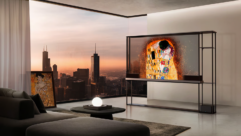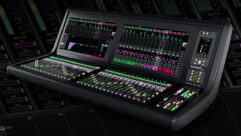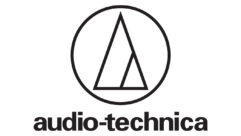
CES 2007: Bigger Still Doesn’t Mean Better
A few products and demonstration gems were found among the piles of gadgets and gimmicks.
FEEDBACK
THIS YEAR’S Consumer Electronics Show had its usual does of chaos with a side of somethings new. Some of the product demonstrations weren’t unexpected. The “mine’s bigger” wars carried on via Sharp’s 108-inch LCD HDTV, while LG Electronics played peacemaker in the blue-laser wars with its dual-format, $1,200 BH100 HD DVD/Blu-ray player.
But there were a few surprises and some real news, if you dug deep enough. Texas Instruments showed it isn’t sitting on its hands in the flat-panel vs. microdisplay rear-projection TV showdown, and two new HDTV trade promotion groups made their debuts at the show.
Alternative illumination systems for rear and front projection were hawked, including RF-excited lamps, LEDs, and several prototype laser light engines. Warner Home Media showed how a packaged media company decisively straddles the blue-laser fence. And a high-resolution video interface battle is joining the blue-laser format war.
Japanese plasma manufacturers set up a “not quite dead yet” exhibit that clearly showed the motion-blur problems with LCD technology. LG and Sony unveiled small to midsize AM OLED HDTV displays. Panasonic proved it can indeed stuff 2 million pixels into a 42-inch plasma. And Novalux demonstrated several laser-powered projection engines.
Some random show highlights worth noting:
DisplayPort: The Video Electronics Standards Association finally — and officially — launched the DisplayPort 1.1 multimedia interface. Unlike HDMI, maintained and licensed by Silicon Image, DisplayPort was designed by association committees to replace the 15-pin analog VGA jack common to desktop and laptop computers.
DisplayPort has multiple channels over which video, audio, control signals, and data can flow through a DisplayPort cable and connector. This is one big advantage DisplayPort has over HDMI, other than being a consensus solution instead of a sole-source interface.
When using all four channels, the maximum bit rate is 10.8 Gb/s (or 2.7 GHz). That’s enough capacity to show 2730 x 1536-pixel resolution (WQXGA) with 10-bit color from source to display. HDMI is capped out at 10.2 Gb/s.
DisplayPort 1.1 can also interface with DVI and HDMI connections, as it incorporates a version of the HDCP copy-protection protocol. According to presenters, a simple adapter cable is all you need to make the hookup.
Samsung Computer and nVidia are getting inquiries from original equipment manufacturers and others about delivering DisplayPort interfaces in new computers. Higher bandwidth may play some part in those inquiries, but it’s a safe bet that lower royalty and licensing costs than HDMI are the real drivers. You might see DisplayPort show up in new HDTVs down the road, too.
Self-calibrating HDTVs: Philips’ 63PFP7422D 63-inch plasma is a rebranded 1080p Samsung model with an aggressive suggested retail price of $3,499. But the real news was an on-screen display setup tool called the Settings Assistant. Its submenu features six different still images with a split-screen dividing line in the middle.
The image settings are different for the left and right sides, and the viewer is prompted to highlight and choose one. As each selection is made, the image parameters (contrast, black levels, etc.) are recorded into memory. I tried the demo myself, and I was quite impressed. If Philips implements Settings Assistant on all its consumer and commercial HDTV displays, it could turn out to be a real winner. Based on my demo, a viewer could set up a plasma or LCD HDTV and be very happy with the results without shelling out a few hundred dollars to a third-party calibrator.
Everything’s blurred: The Advanced Plasma Development Center Corp. had some intriguing demonstrations of motion rendering on LCD and plasma. Some clever engineers developed a camera system that emulates performance of the human eye; it can scan along with moving test patterns for an instantaneous snapshot of image detail at different speeds. This procedure used several multiburst test patterns, but all of them showed a loss of resolution on several LCD monitors and HDTVs. LCD HDTVs with fast refresh rates (120 Hz) had improved performance, but still couldn’t approach the detail seen on a sampling of 50-inch and 60-inch plasma sets that displayed the same patterns at the same speeds.
Panasonic, as an enthusiastic member of the development center, proudly unveiled a 42-inch plasma HDTV with full 1920 x 1080 resolution, joining Hitachi, which did the same at CEDIA Expo 2006. It’s not quite ready for store shelves, but it does offer an effective counterthrust against the wave of 40-inch and 42-inch 1080p LCD monitors and HDTVs charging into retail stores.
The next big thing: As plasma and LCD prices continue to plummet, it’s expected that both technologies eventually will drive conventional, rear-projection displays out of the market. Where does that leave a company like Texas Instruments, whose DLP technology is a pure-projection engine?
The answer apparently will be a super-thin, laser-powered DLP HDTV with the same relative dimensions as plasma and LCD technology. It will be branded as a laser DLP HDTV. The belief is that consumers will consider buying such a product as much as they would plasma and LCD, given the predicted super-thin profile.
Laser DLP sets are a few years away. At Novalux’ laser projection demo, I saw a conventional 50-inch DLP set use a laser-light engine to produce images with plenty of contrast. But their colors weren’t accurate at all when compared to the standard REC.709 HDTV color gamut, and the modified HDTV still required a large footprint and power supplies.
Solomon would be proud: LG Electronics’ BH100 combo blue-laser DVD player attracted a big crowd at its booth and figured prominently in Warner Home Media’s TotalHD demo. The BH100 is a tri-mode DVD player, as it plays HD DVD, Blu-ray, and red laser DVDs.
Warner’s TotalHD format is a combo HD DVD and Blu-ray disc that will play nicely in either machine. Indeed, Warner execs showed an HD DVD clip from “Superman Returns” on Toshiba’s HD-XA2, then popped it into Sony’s BDP-S1 with Blu-ray playback on the huge projection screen. To my eye, the picture quality was identical.
The immediate question was if there is a need for dual-format discs if a dual-format player is available. With dual-format packaged blue-laser DVDs, the winner is the company with the cheapest player, regardless of technology. But with a dual-format player, the trophy goes to the blue-laser disc format with the lowest retail prices and widest availability of titles. Looks like this fight has got quite a few more rounds to go.
Small but beautiful: There hasn’t been much news lately about organic, light-emitting diodes, but LG.Philips and Sony put them back on the front burner with impressive displays of HD-resolution, full-color AM organic, light-emitting diode screens as large as 27 inches. LG.Philips’ demo concentrated on screen sizes more suitable for handheld electronics, while Sony’s 11-inch and 27-inch modules could wind up in second TVs or as hide-away displays in cars.
To comment on this article, email the Pro AV editorial staff at [email protected].
Pete Putman is a contributing editor for Pro AV and president of ROAM Consulting, Doylestown, Pa. Especially well known for the product testing and development services he provides to manufacturers of projectors, monitors, integrated TVs, and display interfaces, he has also authored hundreds of technical articles, reviews, and columns for industry trade and consumer magazines over the last two decades. You can reach him at [email protected].










